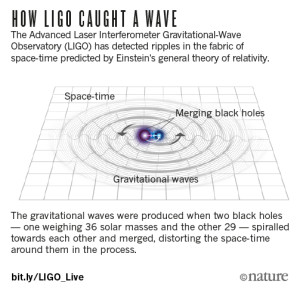 WASHINGTON D.C./MORGANTOWN, W.Va. – For the first time, scientists have observed ripples in the fabric of spacetime called gravitational waves, arriving at the earth from a cataclysmic event in the distant universe. This confirms a major prediction of Albert Einstein’s 1915 general theory of relativity and opens an unprecedented new window onto the cosmos.
WASHINGTON D.C./MORGANTOWN, W.Va. – For the first time, scientists have observed ripples in the fabric of spacetime called gravitational waves, arriving at the earth from a cataclysmic event in the distant universe. This confirms a major prediction of Albert Einstein’s 1915 general theory of relativity and opens an unprecedented new window onto the cosmos.
Gravitational waves carry information about their dramatic origins and about the nature of gravity that cannot otherwise be obtained. Physicists have concluded that the detected gravitational waves were produced during the final fraction of a second of the merger of two black holes to produce a single, more massive spinning black hole. This collision of two black holes had been predicted but never observed.
The gravitational waves were detected on Sept. 14, 2015 at 5:51 a.m. Eastern Daylight Time (09:51 UTC) by both of the twin Laser Interferometer Gravitational-wave Observatory detectors, located in Livingston, Louisiana, and Hanford, Washington, USA. The LIGO Observatories are funded by the National Science Foundation, and were conceived, built, and are operated by Caltech and MIT. The discovery, accepted for publication in the journal Physical Review Letters, was made by the LIGO Scientific Collaboration (which includes the GEO Collaboration and the Australian Consortium for Interferometric Gravitational Astronomy) and the Virgo Collaboration using data from the two LIGO detectors.
WVU scientists make key contributions
West Virginia University astrophysicist Sean McWilliams is a member of the research team that detected the gravitational waves. His work focused on simulating and modeling the gravitational-wave emission in order to detect the incoming signals and infer details about their source.
-Earl Scime
Chair, Department of Physics and Astronomy
For more information about WVU astrophysicist Sean McWilliams and his research, click here.
“This is the culmination of literally hundreds of scientists’ work to build such an incredibly sensitive detector and to predict the details of potential signals with what has turned out to be remarkable accuracy,” McWilliams said.
To read more of the article go here.